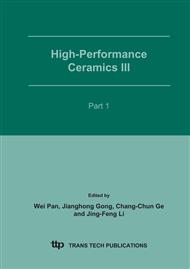[1]
S. Kawashima, M. Nishida and I. Ueda: J. Am. Ceram. Soc. Vol. 66 (1983), p.421.
Google Scholar
[2]
D.A. Sagala and S. Nambu: J. Am. Ceram. Soc. Vol. 75 (1992), p.2573.
Google Scholar
[3]
Baukens, M. Ghodsi and P. H. Duvigneaud: proceedings of third Euro-Ceramic Conference Vol. 2, (Castallon de la plana, Spain 1993).
Google Scholar
[4]
T. Takahashi, E.J. Wu and G. ceder: J. Mater. Res. Vol. 15 (2000), pp. (2061).
Google Scholar
[5]
N. Wakiya, K. Shinozaki and N. Mizutani: J. Am. Ceram. Soc. Vol. 80 (1997), p.3217.
Google Scholar
[6]
F. Willaime: Mater. Sci. Technol. Vol. 17 (2001), p.766.
Google Scholar
[7]
S. Liu, R. Hu and C. Wang: J. Appl. Phys. Vol. 75 (1993), p.3204.
Google Scholar
[8]
Y. Luo and Y. Li: Science in Chinese Vol. 28 (1998), p.20.
Google Scholar
[9]
N. Chen, Q. Lin, W. Ye, Y. Li and S. Y. Liu: Chinese Science Bulletin, Vol. 41 (1996), p.300.
Google Scholar
[10]
F. Li, N. Chen, L. Li and Y. Li: J. Uni. Sci. Technol. Beijing Vol. 7 (2000), p.45.
Google Scholar
[11]
C. Zhao: Solid quantum chemistry-the theory base on chemistry of material (Higher education publishing house, Beijing 1997).
Google Scholar
[12]
Y. Pan, J. Li and J. Zhu: Theory and its application on Xα method, (Science publishing house, Beijing 1987).
Google Scholar
[13]
K. Fukai, K. Hidaka and M. Aoki: Ceramic International Vol. 16 (1990), p.285.
Google Scholar
[14]
F. Lian, L.H. Xu, F.M. Wang, and W.C. Li: J. Mater. Sci. Lett. Vol. 21(2002), p.673.
Google Scholar
[15]
F. Lian, L.H. Xu, F.X. Li, and H.L. Zhao: J. Uni. Sci. Technol. Beijing Vol. 11 (2004), p.48.
Google Scholar
[16]
N. Wakiya, K. Shinozaki and N. Mizutani: J. Am. Ceram. Soc. Vol. 80 (1997), p.3217.
Google Scholar
[17]
C. E. Bambrger, T. J. Haverlock and S.S. Shoup: J. Alloys Compounds, Vol. 204 (1996), p.4.
Google Scholar
[18]
O. Renoult and J.P. Boilot: J. Am. Ceram. Soc. Vol. 75 (1992), p.3337.
Google Scholar
[19]
T. Takahashi: Jpn. J. Appl. Phys., Vol. 39 (2000), p.5637.
Google Scholar
[20]
F. Lian: Investigation of sol-gel synthesis process and dielectric properties of B-site substituted BaTiO3 ceramics (Master Dissertation, University of Science and Technology Beijing 2001).
Google Scholar
[21]
S. Nomura: Ferroelectrics, Vol. 49 (1983), p.61.
Google Scholar


